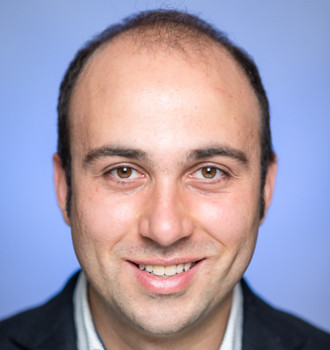Dr Marco Pensalfini
Lecturer in Mechanical and Biomedical Engineering
School of Engineering and Materials Science
Queen Mary University of London
Queen Mary University of London
Research
Bioengineering, Wound Healing, Multiscale Biomechanics, Computational Modeling, Biomaterials, Bioinspired Design
Interests
Computational modeling of spatial patterning in biological systems to rationalize the contribution of microstructural constituents towards cell- and tissue-scale load bearing.Recent work focused on simulations of new tissue formation and remodeling in wound healing, as well as self-organization in cytoskeletal systems such as F-actin and intermediate filament networks.
Publications
2025
 Theory of active self-organization of dense nematic structures in the actin cytoskeleton
Theory of active self-organization of dense nematic structures in the actin cytoskeletonMirza W, De Corato M, Pensalfini M, Vilanova G, Torres-Sánchez A, Arroyo M
Elife, Elife vol. 13
08-12-2025
 Decoding Multiscale Mechanisms in Facial Sagging: Impact of Soft Tissue Deformability, Growth, and Dermal Anchoring on Jowl Formation
Decoding Multiscale Mechanisms in Facial Sagging: Impact of Soft Tissue Deformability, Growth, and Dermal Anchoring on Jowl FormationPensalfini M, Bielicki A, Shaiek A, Dal Belo SE, Santoprete R
Journal of Investigative Dermatology, Elsevier
01-10-2025
2023
 Nonaffine Mechanics of Entangled Networks Inspired by Intermediate Filaments
Nonaffine Mechanics of Entangled Networks Inspired by Intermediate FilamentsPensalfini M, Golde T, Arroyo M
Physical Review Letters, American Physical Society (Aps) vol. 131 (5)
04-08-2023
 Mechano-biological and bio-mechanical pathways in cutaneous wound healing
Mechano-biological and bio-mechanical pathways in cutaneous wound healingPensalfini M, Tepole AB
Plos Computational Biology, Public Library of Science (Plos) vol. 19 (3)
09-03-2023
2020
 How cosmetic tightening products modulate the biomechanics and morphology of human skin
How cosmetic tightening products modulate the biomechanics and morphology of human skinPensalfini M, Rotach M, Hopf R, Bielicki A
Acta Biomaterialia, Elsevier vol. 115, 299-316.
25-08-2020
 Activin-mediated alterations of the fibroblast transcriptome and matrisome control the biomechanical properties of skin wounds
Activin-mediated alterations of the fibroblast transcriptome and matrisome control the biomechanical properties of skin woundsWietecha MS, Pensalfini M, Cangkrama M, Müller B, Jin J, Werner S
Nature Communications, Springer Nature vol. 11 (1)
25-05-2020
2019
 Publisher Correction: Tear resistance of soft collagenous tissues
Publisher Correction: Tear resistance of soft collagenous tissuesBircher K, Zündel M, Pensalfini M, Ehret AE, Mazza E
Nature Communications, Springer Nature vol. 10 (1)
30-05-2019
 On the compressibility and poroelasticity of human and murine skin
On the compressibility and poroelasticity of human and murine skinWahlsten A, Pensalfini M, Stracuzzi A, Hopf R
Biomechanics and Modeling in Mechanobiology, Springer Nature vol. 18 (4), 1079-1093.
26-02-2019
 Tear resistance of soft collagenous tissues
Tear resistance of soft collagenous tissuesBircher K, Zündel M, Pensalfini M, Ehret AE
Nature Communications, Springer Nature vol. 10 (1)
15-02-2019
2018
 Development of a Novel Human Cell-Derived Tissue-Engineered Heart Valve for Transcatheter Aortic Valve Replacement: an In Vitro and In Vivo Feasibility Study
Development of a Novel Human Cell-Derived Tissue-Engineered Heart Valve for Transcatheter Aortic Valve Replacement: an In Vitro and In Vivo Feasibility StudyLintas V, Fioretta ES, Motta SE, Dijkman PE, Pensalfini M, Mazza E, Rodriguez H, Lipiski M et al.
Journal of Cardiovascular Translational Research, Springer Nature vol. 11 (6), 470-482.
13-08-2018
 A novel ultra-light suction device for mechanical characterization of skin
A novel ultra-light suction device for mechanical characterization of skinMüller B, Elrod J, Pensalfini M, Hopf R, Schiestl C
Plos One, Public Library of Science (Plos) vol. 13 (8)
08-08-2018
2017
 Location-specific mechanical response and morphology of facial soft tissues
Location-specific mechanical response and morphology of facial soft tissuesPensalfini M, Weickenmeier J, Rominger M, Santoprete R, Distler O
Journal of The Mechanical Behavior of Biomedical Materials, Elsevier vol. 78, 108-115.
14-11-2017
 The mechanical fingerprint of murine excisional wounds
The mechanical fingerprint of murine excisional woundsPensalfini M, Haertel E, Wietecha M
Acta Biomaterialia, Elsevier vol. 65, 226-236.
12-10-2017
 The suture retention test, revisited and revised
The suture retention test, revisited and revisedPensalfini M, Meneghello S, Lintas V, Bircher K, Ehret AE
Journal of The Mechanical Behavior of Biomedical Materials, Elsevier vol. 77, 711-717.
24-08-2017
2016
 Factors affecting the mechanical behavior of collagen hydrogels for skin tissue engineering
Factors affecting the mechanical behavior of collagen hydrogels for skin tissue engineeringPensalfini M, Ehret AE, Stüdeli S, Marino D, Kaech A, Reichmann E
Journal of The Mechanical Behavior of Biomedical Materials, Elsevier vol. 69, 85-97.
09-12-2016
 Guidelines for standardization of bioprinting: a systematic study of process parameters and their effect on bioprinted structures
Guidelines for standardization of bioprinting: a systematic study of process parameters and their effect on bioprinted structuresKesti M, Fisch P, Pensalfini M
Bionanomaterials, De Gruyter vol. 17 (3-4), 193-204.
19-05-2016
2015
 Challenging the in-vivo assessment of biomechanical properties of the uterine cervix: A critical analysis of ultrasound based quasi-static procedures
Challenging the in-vivo assessment of biomechanical properties of the uterine cervix: A critical analysis of ultrasound based quasi-static proceduresMaurer MM, Badir S, Pensalfini M, Bajka M, Mazza E
Journal of Biomechanics, Elsevier vol. 48 (9), 1541-1548.
26-02-2015
2014
 Evaluation of Global Load Sharing and Shear-Lag Models to Describe Mechanical Behavior in Partially Lacerated Tendons
Evaluation of Global Load Sharing and Shear-Lag Models to Describe Mechanical Behavior in Partially Lacerated TendonsPensalfini M, Duenwald-Kuehl S, Kondratko-Mittnacht J
Journal of Biomechanical Engineering, Asme International vol. 136 (9)
15-07-2014
 A keratin bundling transition uncages the nucleus in stretched epithelia
A keratin bundling transition uncages the nucleus in stretched epitheliaGolde T, Pensalfini M, Chahare N, Roca-Cusachs P, Wiche G, Charras GT, Arroyo M, Trepat X
In Biorxiv
Grants
 Full-field Biomechanical Characterization Of Oral Wounds In Physiological Conditions
Full-field Biomechanical Characterization Of Oral Wounds In Physiological ConditionsMarco Pensalfini
£29,620 Royal Society
31-03-2025 - 31-05-2026









